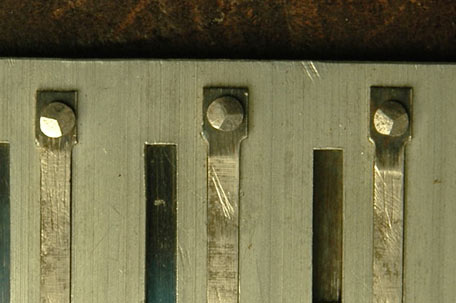

| Carsten Heveling |
| Bando-Aspekte Bandoneon aspects aspectos aspects aspetti |
... zurück back volver retour indietro |
| Die Nietverbindung und das Nachnieten bei der Restaurierungsstimmung |
Rivets and riveting in the restoration tuning |
||||||||||||||
| Die Zungen aller Harmonikainstrumente sind mit dieser einfachen jedoch sehr präzisen und dauerhaften Verbindungstechnik befestigt. Die exakt gestanzten Zungenschlitze und die exakt gebohrten Nietlöcher erzielen einen paßgenauen Sitz (Kaltnietung mit Form- und Kraftschluß). Die Verbindung von Materialien mit Vollnieten soll sich bis in die Bronzezeit zurückverfolgen lassen. Vollnieten werden auch heute noch zur Verbindung voll vollschwingenden Metallteilen verwendet, so im Flugzeugbau. Die Kontrolle der Nieten ist nur in Verbindung mit dem Wechsel der Zungenventile möglich, da die Ventile die Nietrückseite verdecken. Das Nachnieten geht also nur mit sauberen Stimmplatten im Rahmen einer Komplettstimmung ... siehe auch "Stimmung" Das Nachnieten In der Restaurierung nutze ich die sog. "Dreischlagtechnik" (Bild oben). Bei dieser Technik wird der Setzkopf zu seinem Zentrum hin nachgenietet. Der Setzkopf erscheint nicht flach sondern pyramidal mit drei Seiten. Der Setzkopf bleibt "aufrecht". Das zur Befestigung nötige Material wirkt zentral auf den Zungenfuß und wird nicht flach ausgetrieben (Bild unten). Wie schon beschrieben, kann ein Spieler sein Bandoneon durch das Musizieren niemals schädigen (siehe "Stimmtechniken"). Der Stimmer jedoch kann mit seinen Stimmfeilen nur Material von den Stimmzungen entfernen und die Nieten nicht wieder aufrichten. Fehler beim Stimmen (Feilen auf den Zungen) und beim Nachnieten sind irreversibel. So ist der Zustand von den Stimmplatten, den Stimmzungen und den Nieten der zentrale Aspekt für die technische Bewertung eines klassischen Bandoneons. Im Rahmen der Restaurierungsstimmung ist die Kontrolle der Nietverbindungen inbegriffen ... siehe auch "Stimmung" Fachmännische Arbeit erhält unsere Bandoneons und macht sie in den Händen von Musikern zu unzerstörbaren Instrumenten die schon jetzt über die Generationen gespielt werden.
Rivets The reeds of all harmonic instruments are attached with this simple but very precise and durable connection technique. The precisely punched tongue slots and the precisely drilled rivet holes achieve a tight fit (cold riveting with form closure and frictional connection). The union of materials with solid rivets should be traced back to the Bronze Age. Solid rivets are still used today to connect fully vibrating metal parts, such as in aircraft building. The control of the rivets of a bandoneon is only possible in connection with the change of the reed valves. The valves cover the back of the rivets. The riveting works can only be done with clean reedplates in the context of a complete tuning. In the restoration I use the so-called "three-beat technique" (picture above). In this technique, the rivet head is riveted to its center. The rivet head does not appear flat but pyramidal with three sides. The rivet head remains "upright". The material needed for fixing acts centrally on the reed head and is not flatly (picture on the right). As already described, a bandoneon player can never harm his bandoneon by making music. The tuner, however, can only remove material from the reeds with its metal files and not reerect the rivets. Errors when tuning (filing the reeds) and riveting are irreversible. Thus, the state of the reeds, the reedplates and the rivets is the central aspect for the technical evaluation of a classic bandoneon. As part of a restoration tuning, the inspection of the rivets is included. Expert work brings out and conservates the incomparable beauty of our bandoneons and makes them in the hands of musicians to indestructible instruments that are already played over the generations.
|



|
| © 1998-adhuc BANDO BANDO Wuppertal | |
| Kontakt / Impressum Datenschutzhinweis & Hinweise zur Nutzung |